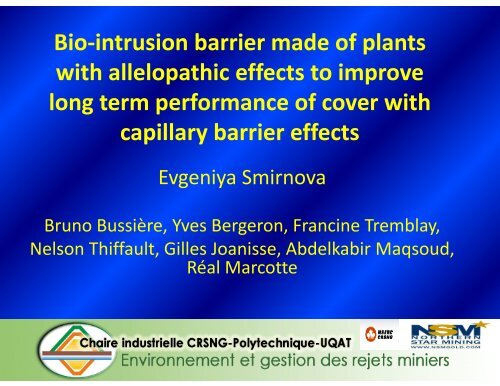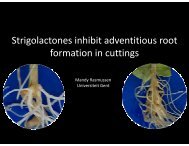Bio-intrusion barrier made of plants p with allelopathic effects to ...
Bio-intrusion barrier made of plants p with allelopathic effects to ...
Bio-intrusion barrier made of plants p with allelopathic effects to ...
Create successful ePaper yourself
Turn your PDF publications into a flip-book with our unique Google optimized e-Paper software.
<strong>Bio</strong>‐<strong>intrusion</strong> <strong>barrier</strong> <strong>made</strong> <strong>of</strong> <strong>plants</strong> p<br />
<strong>with</strong> <strong>allelopathic</strong> <strong>effects</strong> <strong>to</strong> improve<br />
long term performance <strong>of</strong> cover <strong>with</strong><br />
capillary <strong>barrier</strong> <strong>effects</strong><br />
Evgeniya Smirnova<br />
Bruno Bussière, Yves Bergeron, Francine Tremblay,<br />
Nelson Thiffault, Gilles Joanisse, Abdelkabir Maqsoud,<br />
Réal Marcotte
CCBE<br />
Objective : <strong>to</strong> limit the oxigen<br />
migration, hence Acid mine<br />
drainage (ADM ) generation<br />
How? by maintaining one <strong>of</strong> the<br />
layers at high water saturation<br />
level by using the <strong>effects</strong> <strong>of</strong><br />
capillary <strong>barrier</strong> (Aubertin et al.<br />
1995; Dagenais et al. 2005)<br />
Concern : good performance in<br />
short-term, but not clear long-term g<br />
performance (Bussiere et al. 2009)<br />
<strong>Bio</strong>-<strong>intrusion</strong> <strong>Bio</strong> <strong>intrusion</strong> (Trépanier et al.<br />
2006 ; Smirnova et al. 2009-CLRA)<br />
Configuration <strong>of</strong> the CCBE<br />
Surface layer<br />
Protection layer<br />
Drainage layer<br />
Moisture retaining layer<br />
Support layer<br />
Tailings<br />
2FeS<br />
4<br />
2+<br />
2−<br />
+<br />
2 + 7O2<br />
+ 2H2O<br />
→ 2Fe<br />
+ 4SO4<br />
+ H<br />
E. Smirnova et al., Amos, 2011
Example : CCBE <strong>of</strong> the Lorraine mine site<br />
‐Cu‐Zn mine, operating since 1964 <strong>to</strong> 1968<br />
‐ 600 000 t <strong>of</strong> residuals on the area <strong>of</strong> 15.5 ha<br />
‐ AMD‐generating tailings<br />
‐CCBE constructed in 1998 by the MRNF<br />
‐CCBE CCBE <strong>of</strong> three layers: 30 cm /50 cm / 30 cm<br />
‐ AMD moni<strong>to</strong>ring<br />
‐Vegetation survey: 2003, 2005, 2007, 2008<br />
0<br />
‐20<br />
‐40<br />
‐60<br />
‐80<br />
‐100 100<br />
‐120<br />
‐140 140<br />
‐160<br />
‐180 180<br />
Depth <strong>of</strong> tree roots<br />
Willow<br />
Bals Bals.<br />
Bl Bl.<br />
sp. Alder J. Pine Poplar Aspen Larch P.Birch Spruce<br />
Root depth, cm
PROBLEMATIC<br />
Main riscks associated <strong>to</strong> bio-<strong>intrusion</strong> on the CCBE<br />
Development <strong>of</strong> roots may cause :<br />
1. Water saturation reduction<br />
2. Macroporozity<br />
3. Physical deterioration:<br />
a) ) up-rooting g( (ex. spruces) )<br />
b) stem break-up (ex. aspen)<br />
(DOE 1990; Handel et al. 1997;<br />
Hutchings et al. 2001)<br />
PPotential t ti l bi bio-<strong>barrier</strong>s b i<br />
(Cooke and Johnson 2002)<br />
E. Smirnova et al., Amos, 2011
Allelopathic Effects<br />
Allelopathic <strong>effects</strong> : inhibition <strong>of</strong> germination and growth <strong>of</strong> a certain<br />
species <strong>of</strong> plant, by the use <strong>of</strong> another<br />
Competitive<br />
depletion<br />
Allelopathic<br />
interference<br />
Space<br />
Litter<br />
Light<br />
Pluviolessivates<br />
Wt Water<br />
Nutrients<br />
RRoot texudation dti<br />
Indirect sources <strong>of</strong><br />
interference<br />
Soil microorganisms<br />
Harboring b i <strong>of</strong> f herbivores h bi<br />
Etc.<br />
(Fuerst and Punam, 1983; Siciliano and Germida 1998; Vivanco et al. 2004)<br />
E. Smirnova et al., Amos, 2011
Impact <strong>of</strong> the <strong>allelopathic</strong> compounds on the roots<br />
Many Many allelopchemicals inhibit root growth ex. monotrepents<br />
Stress <strong>effects</strong> are dose-dependent: depend on the duration and<br />
intensity intensity, in which the stressing agents act act, on the species species, variety and<br />
plant individual status and environmental conditions<br />
A A linear relationship between the level <strong>of</strong> root contact <strong>of</strong> inhibi<strong>to</strong>ry<br />
concentrations <strong>of</strong> phy<strong>to</strong><strong>to</strong>xin and plant inhibition and very poor <strong>to</strong> no<br />
relationship betweeen phy<strong>to</strong><strong>to</strong>xin uptake and plant inhibition<br />
Eu-stress and dis-stress<br />
(Lichtenthaler, 1996; Pedrol, N., 2006)<br />
E. Smirnova et al., Amos, 2011
OBJECTIVES<br />
1) To introduce bio‐<strong>barrier</strong> species <strong>with</strong> known<br />
<strong>allelopathic</strong> <strong>effects</strong> <strong>to</strong> an existing CCBE<br />
2) To evaluate two fac<strong>to</strong>rs: the production <strong>of</strong> phy<strong>to</strong>‐<strong>to</strong>xins<br />
and resource limitation <strong>of</strong> bio‐<strong>barrier</strong> species on the<br />
target tree species<br />
‐ TTo assess the h impact i <strong>of</strong> f the h AE species i on the h root<br />
system characteristics <strong>of</strong> target tree species [trembling<br />
aspen aspen, balsam poplar, poplar black spruce, spruce willows, willows and<br />
speckled alder]<br />
4) To evaluate the effect <strong>of</strong> AE species on CCBE water<br />
balance<br />
E. Smirnova et al., Amos, 2011
HYPOTHESIS<br />
11. Direct resource competition and <strong>allelopathic</strong><br />
interference <strong>of</strong> potential bio‐<strong>barrier</strong> species<br />
inhibit target tree species’ growth<br />
Roots <strong>of</strong> target trees<br />
a. Phy<strong>to</strong><strong>to</strong>xins decrease fine root biomass<br />
b. Phy<strong>to</strong><strong>to</strong>xins optimise coarse root ramification<br />
bb. Allelopthic <strong>effects</strong> inhibit coarse root growth<br />
&<br />
E. Smirnova et al., Amos, 2011
Boreal <strong>plants</strong> <strong>with</strong> <strong>allelopathic</strong> <strong>effects</strong><br />
Sheep laurel<br />
Labrador tea<br />
Bluejoint reedgrass<br />
black spruce, balsam fir, red pine<br />
(Titus and English 1996; Mallik and Inderjit 2001;<br />
Thiffault et al. 2004; Thiffault and Jobidon 2006; etc.)<br />
black spruce p<br />
(Nilsen et al. 1999 ; Mallik and Bloom 2005;<br />
Fen<strong>to</strong>n et al. al 2005; 2005 Lavoie La oie et al. al 2006; 2006 etc. etc )<br />
ttrembling bli aspen, white hit spruce<br />
(L (Landhäusser dhä and d Li Lieffers ff 1998 1998;<br />
Landhäusser et al. 1996; Collet et al. 2006; etc.)<br />
E. Smirnova et al., Amos, 2011
THE LTA MINE SITE<br />
Terri<strong>to</strong>ry <strong>of</strong> 60 ha, contains 12 m<br />
<strong>of</strong> sulphide tailings placed over<br />
5 m <strong>of</strong> non acid-generating<br />
material (Bussière et al., 2006)<br />
In 1995-1996, the LTA site was<br />
rehabilitated using a CCBE<br />
Hydroseeding on the slopes<br />
Vegetation succession<br />
Mechanical eradication<br />
E. Smirnova et al., Amos, 2011
WET<br />
EXPERIMENTAL DESIGN<br />
DRY<br />
Experimental Block<br />
Pop Asp Wil Spr Ald<br />
lar en low uce er<br />
Laurel+trees<br />
Labrador tea+trees<br />
RReedgrass d + trees<br />
Experimental Plot 200 m between Eco<strong>to</strong>ps<br />
50 m between Blocks<br />
3x3 m Experimental Plot size<br />
5 5 m between Experimental Plots<br />
E. Smirnova et al., Amos, 2011
Recolt and planting <strong>of</strong> Laurel and Labrador tea<br />
( (2008, 2009) )<br />
E. Smirnova et al., Amos, 2011
Bl Balsam poplar l<br />
Willow<br />
Planting <strong>of</strong> trees<br />
Speckled Alder<br />
Black spruce +Sheep laurel Willow+Sheep laurel<br />
Black spruce<br />
E. Smirnova et al., Amos, 2011
Plant survival<br />
E. Smirnova et al., Amos, 2011
Sampling p gand<br />
measurements<br />
1. Soil<br />
temperature p<br />
44. Soil and plant tissue<br />
6. Water budget<br />
7. <strong>Bio</strong>chemical analyses<br />
8. Ecophysiological measurements<br />
2. Pluviolessivates<br />
3. Root exudates<br />
E. Smirnova et al., Amos, 2011
Tree root study<br />
• Tree root architecture and <strong>to</strong>pology<br />
• Coarse root volume and biomass<br />
• Fi Fine root biomass bi<br />
E. Smirnova et al., Amos, 2011



